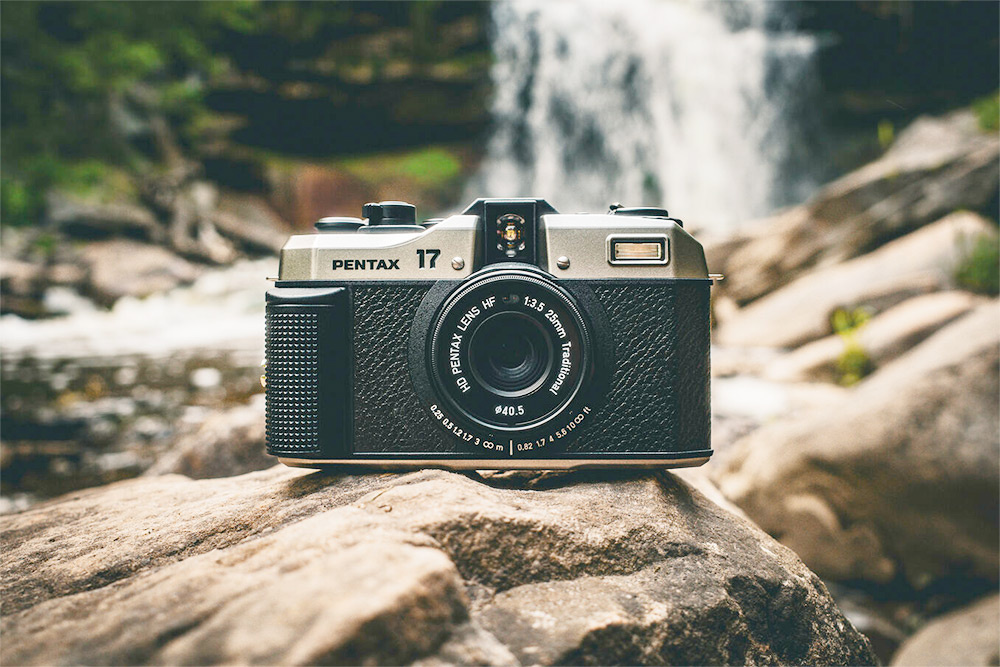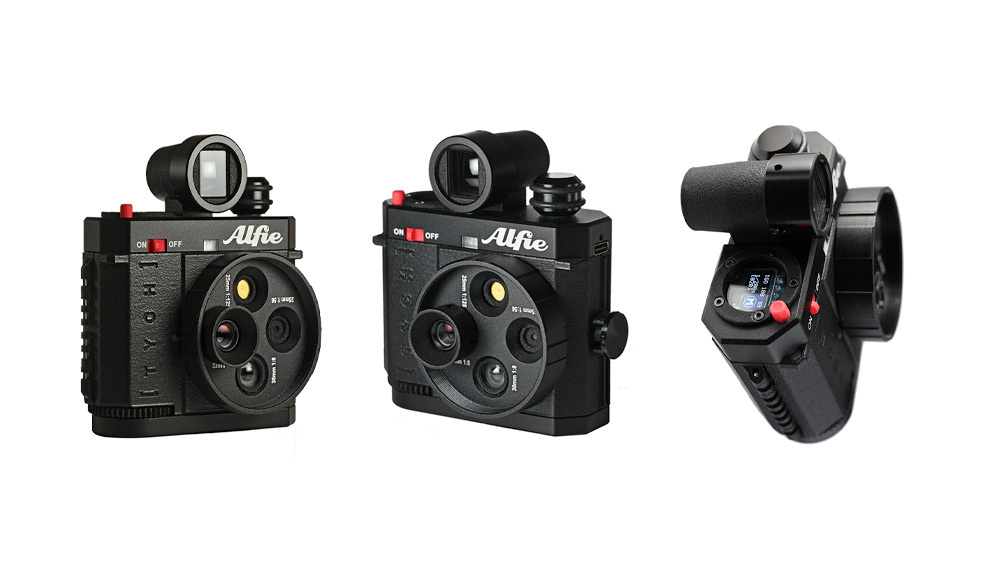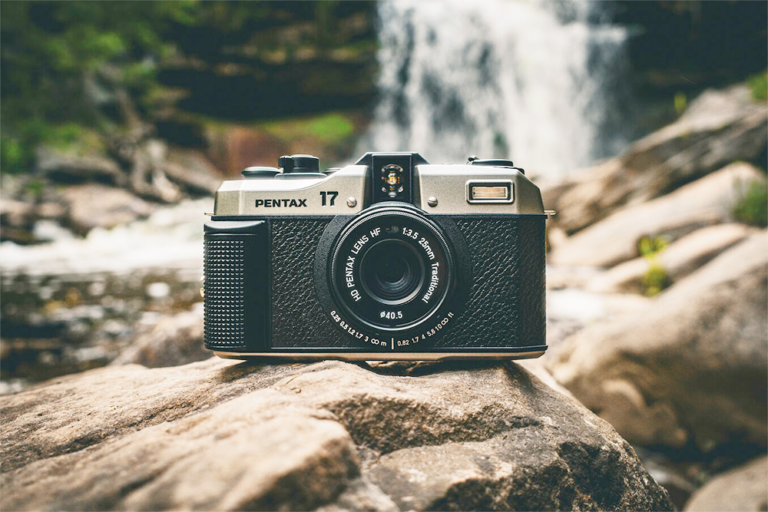A half-frame film camera could be the perfect Christmas gift. Make the right choice with this handy guide.
Designed to let you get twice as many shots (and sometimes more) from a roll of 35mm film, half-frame cameras are an ideal option for anyone interested in dipping a toe into the world of film photography, or film aficionados who want something fun and accessible.
There are half-frame cameras to suit a variety of budgets, each with its own idiosyncrasies and compromises, and while image quality isn’t a huge concern, there are some factors to take into consideration depending on how and when you want to take photos.
A Quick Word About Focusing
Forget autofocus. Instead, focusing largely falls into two categories:
- Fixed focus — As long as it’s more than a couple of feet away from you, it’ll be in focus. Just about.
- Zone focus — Estimate the distance to your subject and choose the right symbol on the focusing ring.
There is a third option — through-the-lens focusing — but this is only available on the Olympus PEN F range of cameras. More on this later. (Arguably there’s a fourth option but these models start at around $25,000.)
Boxfresh or Pre-Loved?
First, you’ll need to decide whether you want to buy something brand-new or venture into the second-hand market. Despite film’s resurgence in popularity, there are still only a handful of brand-new half-frame cameras available today and most of them are made of plastic. For anyone keen to snag something vintage, there’s a wealth of choice, but inevitably there are some aspects to be aware of.
Here are the best options out there:
Pentax 17

Launched earlier this year, the Pentax 17 took the photo industry by surprise. Pentax had teased the prospect of a new film camera, but few expected it to be a half-frame point-and-shoot.
There are countless opinions on what Pentax should have done differently but none of these take away from the fact that the 17 is an amalgamation of intelligent compromises that ensure a broad appeal. At $500 it’s likely to be the most expensive item on this list (the second-hand market can be very random), but the 17 is the only new option that is not predominantly plastic and comes with something unique: a 6-month warranty and the confidence that should something go wrong, you can send it off for repair.
In terms of usability, it covers a lot of bases; like most half-frame cameras, you can hand it to someone who has never used a camera before and all they need to do is look through the viewfinder and push a button. For those who want a bit more control, there are a couple of modes to choose from.
The camera uses zone focusing, dialed in with a set of symbols, and while it’s a tried and tested method of photographing, it can take some getting used to. The minimum focusing distance is an impressive 0.82’ (25cm) and the wrist strap intelligently doubles as a tape measure for nailing those macro shots.
The Pentax 17 takes a CR2 3V battery that powers not only the light meter but also the flash. With a maximum aperture of f/3.5, that flash might well come in handy.
In summary, it costs more than any of the other cameras on this list, but describing it as expensive is unfair given its modern build, sleek design, and wealth of features — not to mention the warranty.
Kodak Ektar H35N, Lomography Lomourette, and Lomography LC-Wide 35
Although they’re both positioned squarely at the ‘fun’ end of the scale, that’s not to say that you can’t use them to create great images. The plastic lenses are sharp enough in bright conditions, and you’ll need a lot of light given their limited apertures and shutter speeds. To combat the tiny apertures, both feature a flash — not exactly hard to spot on the Lomourette.
You’ll have very little control but for the money, you can hardly complain. Chuck in a roll of something equally fanciful, throw around the words “lofi” and “plastic fantastic”, and go nuts.
The Lomography LC-Wide is a unique proposition, offering the choice of full-frame, square, or half-frame for each individual image. At $400, it’s not cheap, however, and for that price, I’d want a few more controls than just the frame size.
Alfie Tych
 Most half-frame cameras are anomalies, but the Alfie Tych takes it to the extreme. Designed and produced by a tiny, family-run business in the UK, the Tych arrived a few years ago via a kickstarter and doesn’t seem sure whether it’s a toy or a serious proposition — and that’s meant as a complement.
Most half-frame cameras are anomalies, but the Alfie Tych takes it to the extreme. Designed and produced by a tiny, family-run business in the UK, the Tych arrived a few years ago via a kickstarter and doesn’t seem sure whether it’s a toy or a serious proposition — and that’s meant as a complement.
It seems that every side of the camera offers something unexpected, from the rotary lens, the USB charging, to the digital display. Image quality seems to be what you’d expect but reports are that you can squeeze 81 photos onto a standard 36-exposure roll of 35mm film. That’s ridiculous.
There are two models available at $375 and $630, with the more expensive of the two offering better optics.
Second-Hand Options: Olympus
It feels like there are as many Olympus models available as there are other cameras put together. In the 60s and 70s, Olympus put out a ton of different models, all beautifully designed and now plentiful on eBay and beyond.
I could dedicate an entire article to describing the differences but here’s a quick summary of how they differ.
Of the versions with a light meter, there are two different power sources: a light-powered selenium cell or a mercury battery. While the selenium cells are convenient, they will eventually die and cannot be replaced. The disadvantage of a mercury battery is that they no longer exist, so you’ll have to swap it out for a modern alternative, which comes with its own small complications.
Focusing comes in three flavors: fixed, zone-focusing (i.e., guess the distance and pick a symbol), and SLR-esque through the lens. Along with the interchangeable lenses (including zooms!) and the FT’s surreal insistence that you do some math when setting the exposure, the SLR design is what makes the renowned PEN F series distinctive. (If they’d combined this with aperture-priority auto-exposure, for me it might have been the ultimate film camera.)
The advantage of the PEN series is that there are some impressive apertures available such as the 32mm f/1.7 lens available on the PEN EED, making it far more appealing as an everyday carry.
Second-Hand Options: Everything Else
The other major manufacturers never got quite as carried away with half-frame as Olympus but Canon, Ricoh, and Yashica have solid cameras available. The pick is probably Canon’s Demi EE17 — beautifully designed but the controls are not exactly intuitive. Many of the cameras are similar to the Olympus PEN range, but a few, but there are some 1980s-weirdness-infused oddities out there, such as the Yashica Samurai and the Belomo Agat 18k.
Buying Old Cameras Online
There are lots of excellent Japanese sellers on eBay with a seemingly endless supply of Olympus PENs available, and in my experience, you can buy with confidence. Furthermore, I’ve bought three Olympus film cameras from Japan and they’ve each arrived here in France via courier in a matter of days.
However, note that even if a camera is tested, there’s no guarantee that it will maintain its performance in the long term. Most half-frame cameras are at least 30 years old, and my own beautiful, capricious Olympus PEN EE-2 could well be over 50 years old. The plastic innards of these gorgeous machines eventually start to struggle, and, as noted above, a selenium-powered light meter will eventually stop working.
Keep in mind also that, despite the lightweight mechanisms, these cameras are surprisingly heavy. An Olympus PEN EE-2 will squeeze into a large trouser pocket, but you’ll probably need a belt.
In Summary
We’re yet to catch up with the choice available in the 60s and 70s but these 50-plus-year-old cameras are an excellent complement to the growing number of newly manufactured options, giving us a huge selection. Be sure to let me know in the comments which camera you would choose and why.
